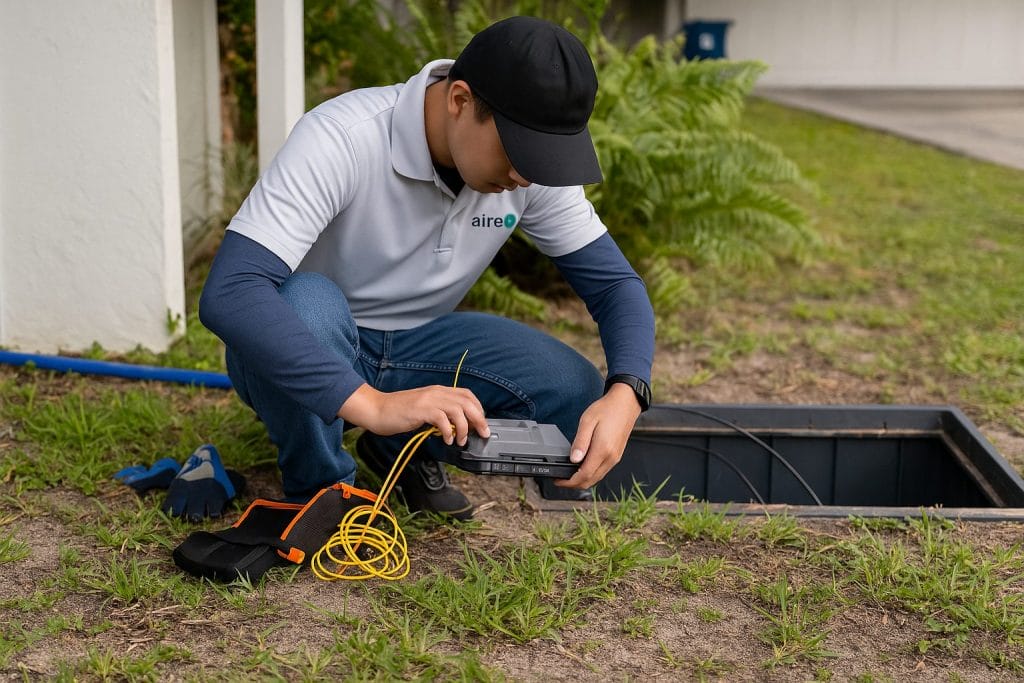Your territory assignments look perfect on paper. High-density neighborhoods, growing business districts, qualified prospects who actually need better connectivity. Yet you’re watching team quota slip away while competitors seem to close deals effortlessly in the same market.
The difference isn’t territory luck or product superiority. Top telecom teams crack the code on systematic execution – they convert residential prospects at 6%+ rates while average teams convert at 2-5%, and they leverage technology to achieve higher quota attainment than teams relying on traditional methods.
The gap between your team’s current performance and their potential isn’t about working harder. It’s about optimizing the systems that turn daily activities into consistent revenue.
Why Telecom Teams Miss Quota
Your reps know their products, understand their markets, and work consistently. So why aren’t they hitting quota? Three things kill performance:
- Territory Inefficiency: Poor route planning productive time as reps travel between disconnected residential neighborhoods and business districts.
- Activity Invisibility: Without real-time field visibility, you can’t coach what you can’t see, missing optimization opportunities that compound over time.
- Data Fragmentation: Manual prospect tracking creates follow-up gaps that lose qualified opportunities across both residential and business markets.
12 Telecom Sales Strategies
1. Optimize Your Territories
Stop letting your team burn windshield time between random stops. According to McKinsey, field sales reps can spend nearly 45% of their time on non-selling activities including driving, admin work, and internal support—time that should be spent with prospects.
Deploy territory mapping that clusters prospects by type and location—grouping 15-20 business accounts within 2-mile commercial zones for focused morning blocks, and creating residential neighborhoods of 50-75 homes for efficient evening canvassing.
Smart territory design considers traffic patterns, prospect density, and account value to create routes that maximize both residential door coverage and business relationship building.
Success story: Wire3 cut their drive time from 35% to 12% of field hours through systematic clustering, transforming wasted windshield time into productive customer conversations.
2. Deploy Real-Time Activity Tracking
Transform your role from scorekeeper to performance coach. Platforms providing instant field visibility enable coaching conversations based on actual activities rather than end-of-week reports.
Success story: Chipr’s leadership achieved their 6% close rate targets by implementing systematic activity monitoring that revealed which approaches generated highest conversion rates – then scaled those techniques across their entire team.
3. Enable Mobile-First Prospect Management
Eliminate the choice between detailed notes and productive selling time for your reps. Mobile CRM systems like SPOTIO allow field sales reps to capture comprehensive prospect information while maintaining conversation flow.
Ensure every customer interaction stays accessible, enabling personalized follow-ups whether reps are revisiting residential prospects or advancing complex business evaluations.
4. Optimize Conversion Rates by Market Segment
Don’t combine residential and business performance into single reports. Track door knocks separately from business meetings—they’re fundamentally different activities with different success patterns.
When you measure them together, you can’t tell if your team struggles with quick residential closes or extended business relationship building. Separate tracking reveals exactly where coaching and process changes deliver results.
5. Master Market-Specific Execution: B2B vs B2C
If they’re working both residential and business markets in the same territory, your sales reps face unique execution challenges:
- Residential buyers respond to same-day close opportunities, requiring immediate-close techniques and 7-day follow-up windows that target 8%-10% conversion.
- Business deals involve 6-10 stakeholders for mid-market accounts, average 33 days for SMBs (extending to 4-6 months for enterprise), targeting industry-average 12.7% conversion through relationship-based nurturing.
What to do: implement separate CRM pipelines tracking residential velocity (7-day cycles) versus business relationship development (60+ day cycles). Use market-appropriate urgency: installation timing and limited promotions for residential, quarterly budget cycles and contract renewals for business.
For complex B2B deals, map stakeholder engagement across IT, operations, and financial approvers to ensure comprehensive buying committee coverage.
6. Leverage Predictive Lead Scoring
Help your team focus limited time on prospects most likely to buy. AI-powered analytics analyze behavioral signals, demographic patterns, and competitive intelligence to prioritize daily activities based on conversion probability.
For residential telecom sales, SPOTIO’s Lead Machine filters results across 50+ data points, helping your reps surface qualified opportunities faster in both residential and business markets.
7. Standardize Market-Specific Objection Handling
Develop response frameworks that address real concerns in each segment across your entire team. Residential prospects worry about price and disruption, while business decision makers focus on reliability and implementation complexity.
Residential Training: Address cost concerns with total value analysis showing long-term savings
Business Training: Demonstrate ROI through productivity improvements and operational efficiency gains
8. Implement Systematic Follow-Up Sequences
Ensure your team matches outreach cadence to how each market segment actually makes decisions. Residential prospects often choose within days, while business prospects require weeks of evaluation.
Deploy automated sequences ensuring qualified prospects never fall through pipeline gaps, with messaging personalized for each market’s decision timeline and information needs.
9. Utilize Seamless CRM Integration
Connect field activities to existing systems without creating additional work for your team. Leading platforms integrate with current CRM and marketing tools, ensuring prospect data flows automatically where it needs to go.
SPOTIO eliminates training headaches by working with existing telecom sales tech stacks, enhancing rather than disrupting established processes.
10. Deploy AI-Powered Sales Assistance
Provide your team intelligent coaching during customer conversations through AI assistants designed for field sales scenarios. Advanced platforms provide real-time suggestions for objection handling and competitive positioning based on prospect characteristics.
Transform every interaction into a learning opportunity that improves future performance across both residential and business engagements.
11. Scale Hybrid Training Excellence
Enable your team to switch seamlessly between market segments without losing effectiveness. Develop skills in both door-to-door psychology for residential customers and consultative selling for business prospects.
Focus training on transition techniques that let reps adjust their approach instantly based on prospect type and decision-making environment.
12. Scale Through Performance Analytics
Identify what’s working across your territories and eliminate what’s wasting time. Advanced analytics reveal patterns showing which neighborhoods convert best and which business types offer highest-value opportunities.
Use data-driven insights to replicate successful approaches across territories while cutting low-ROI activities that consume energy without generating results.
Essential Technology Requirements
Here’s what your tech stack needs to handle both residential canvassing and business accounts:
Essential Team Capabilities:
- Mobile-First Design: Functionality optimized for field conditions and varying connectivity
- Real-Time Visibility: Activity tracking enabling immediate coaching and optimization
- CRM Integration: Seamless data flow without implementation disruption
- AI Enhancement: Predictive analytics and intelligent assistance for better team decisions
Teams like Chipr using comprehensive engagement platforms achieve 46% productivity increases through systematic execution and data-driven optimization.
90-Day Strategy Rollout
Week 1-2: Fix Your Territory Assignments
Map where your reps are actually spending time. Spot the gaps where business accounts and residential neighborhoods overlap poorly, forcing reps to zigzag across town.
Week 3-4: Get Everyone on the Platform
Roll out mobile tools that show you what’s happening in the field—no more waiting until Friday to see who hit quota. Start with route optimization so reps spend less time driving.
Month 2: Train for Both Markets
Run separate sessions on door-to-door techniques and business account development. Your reps need to switch gears fast when they move between residential streets and commercial districts.
Month 3+: Double Down on What Works
Pull the conversion reports by market type. Find your top performers’ patterns and teach the rest of the team. Cut activities that burn time without closing deals.
Key Takeaways
Telecom sales rewards consistency, not heroics. Your best reps already know what works—the challenge is getting your entire team executing at that level across both residential and business markets.
The strategies above give you the playbook. Territory clustering cuts drive time. Real-time tracking shows you what’s actually happening. Market-specific training helps reps switch between door knocks and business meetings. Performance analytics show you what to scale and what to cut.
Need help making this happen? SPOTIO’s mobile platform gives you real-time field visibility, territory optimization, and automated tracking that cuts admin work. Chipr hit their close rate targets. Wire3 boosted activity 309%. Your team could see similar gains—46% productivity increases are typical when reps spend less time on paperwork and more time with prospects.
FAQ
Why do experienced telecom teams still miss quota?
Territory inefficiency and poor activity tracking kill even experienced teams. Reps waste 45% of their day driving between random stops, and managers can’t coach what they can’t see. Without mobile tools showing real-time field activity, qualified prospects slip through gaps in follow-up. The fix: systematic territory clustering and instant visibility into what reps are actually doing.
What’s the biggest difference between successful and struggling teams?
Successful teams replicate what works through documented processes and real-time coaching. Struggling teams rely on individual heroics that can’t scale. Chipr hit their 6% close rate targets by implementing systematic activity tracking . Wire3 achieved 309% activity increases through structured territory management. The difference isn’t effort—it’s having systems that turn effort into consistent results.
How can I improve conversion rates in both residential and business markets?
Track them separately—they’re completely different sales motions. Residential targets 8-10% conversion through fast door approaches and 7-day follow-ups. Business targets 12.7% through relationship building with 6-10 stakeholders over 33+ days. Train your team differently for each market. Perfect same-day closes for residential, multi-stakeholder management for business.
What technology makes the biggest impact for telecom teams?
Mobile-first CRM with GPS route optimization, real-time activity tracking, and offline functionality. Must work in the field, not just at a desk. Essential features: automated data capture during customer conversations, territory clustering to cut drive time, and integration with your current CRM. Wire3 cut drive time from 35% to 12% through systematic routing.
How quickly can teams see results?
Fast. Chipr hit target close rates within months . Wire3 saw 309% activity jumps immediately. Typical timeline: Week 1-2 better activity visibility, Month 2 conversion improvements, Month 3+ significant quota gains. Speed depends on your team’s adoption and how well the platform fits your existing workflow.
What’s the most important capability for sales leaders?
Real-time field visibility. See what reps are doing NOW, not Friday afternoon. Lets you coach based on actual behavior patterns, spot what’s working across top performers, and replicate it across the team immediately. Transforms you from scorekeeper to performance coach.
How should I balance residential canvassing versus business development?
Cluster them geographically, not chronologically. Group 15-20 business accounts in 2-mile zones for morning blocks. Create residential pods of 50-75 homes for evening sprints. Don’t dedicate entire days to one segment—reps should hit business prospects mid-morning and mid-afternoon when decision-makers are available, then switch to residential evenings. Track conversion separately by segment to see where each rep excels.




